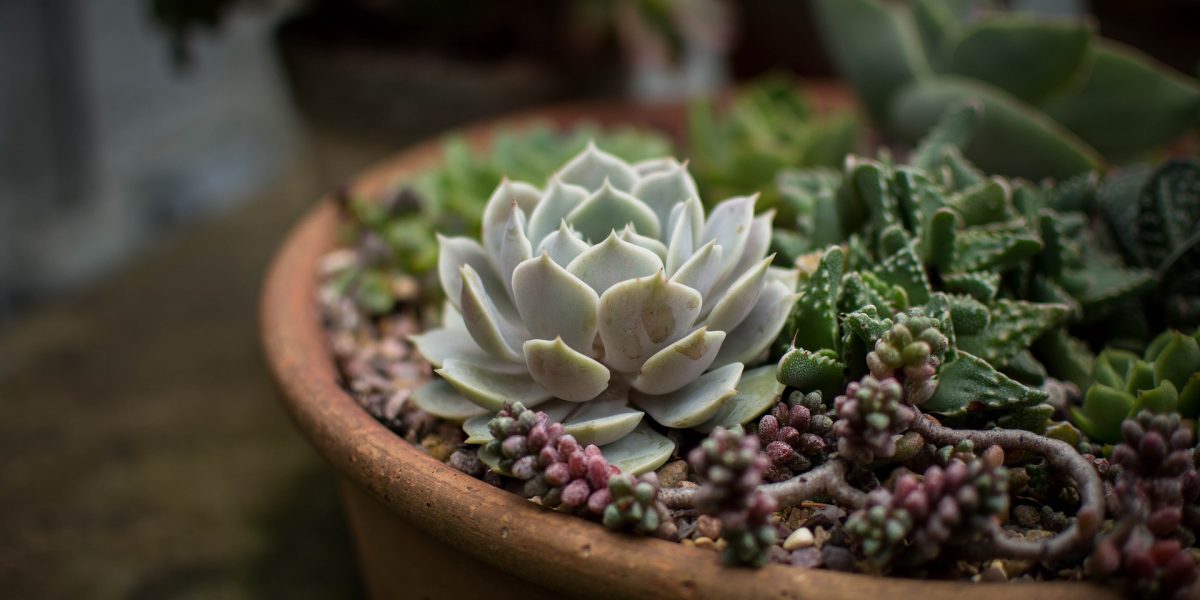Cacti and succulents are some of the easiest and most unique plants to keep. They have adapted to succeed in some of the harshest environments in the world, including my house. If you have trouble keeping things alive in your household, succulents may be your answer.
Derived from the Latin word “sucus” which means juice, Succulents are plants that store water. Because they store water, they are very resistant to drought. Their appearance differs from species to species but one common trait is swollen leaves, pads or stems due to their water retention.
Succulents are similar to cacti in that the key to a happy environment is treating it as if it’s living in the desert. Warm sunny days and cool nights with very little water are ideal. Deserts don’t have winters like Canada so not all succulents are able to survive the Canadian winters outside. Hens and Chicks are one of the heartier succulents that can survive the Canadian winters. They simply go dormant during winter months but come April you’ll see them gradually come back to life.
Succulents have been around for a long time, often used as desktop plants or indoor potted plants.
Their popularity has increased over the last decade due to their reputation of being one of the easiest plants to care for. They’re low maintenance, requiring very little watering or pruning. They come in a variety of shapes, colours and sizes. They don’t attract insects or pests and they won’t overgrow their planter.
Most succulents have fragile shallow roots. Therefore, when removing from the store-bought containers, take caution not to damage the roots. They should be set shallow in prepared soil gently tamping the soil down as you go. Cover the soil with coarse sand and water to allow the soil around the roots to settle.
Though succulents don’t require much water, how they are watered makes a big difference. They do not like to be misted which people often do to avoid over watering. The best way to water your succulent is to soak the soil completely and then allow it to completely dry out before watering again. The succulent itself prefers not to be wet so watering direct to the soil is ideal.
4 Steps to Succulent Success
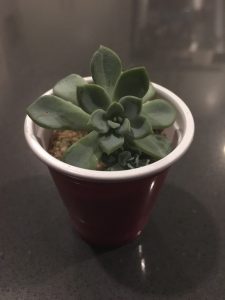
Another interesting thing about succulents is there ability to be propagated very easily. You can easily turn one succulent in to as many as you like.
- To start a new succulent from one that’s already blooming you will need to remove a leaf from the underside of the plant. NOTE: Be sure to remove the leaf in its entirety.
- Place the leaf in a dry area for a few days and allow the stem to become calloused. Once calloused, the leaf will appear spotty, discoloured and brittle. These are telling tale signs your leaf is ready to be put on soil.
- Place your leaf on top of a pot (I use red solo cup shot glasses) of well draining soil and water the soil once a week. After a few weeks pass by, you’ll notice your leaf is beginning to grow roots.
- When the roots appear, you’re going to carefully remove them from the leaf and plant them shallow in the soil. After a couple of weeks, you’ll have an adorable new succulent to add to the family.
Because succulents are so easy to propagate, they make great gifts. Pot a few for your kids room; give some out to your local school and library; make some for your brother who can’t even keep a goldfish alive.
Whether you keep your succulents outdoors or have them in pots inside your home, they make any space happier. Its easy to smile at their beauty.
5 Popular Succulents
for your home and garden
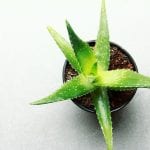
Aloe Vera
Aloe vera is a succulent plant species of the genus Aloe. An evergreen perennial, it originates from the Arabian Peninsula but grows wild in tropical climates around the world and is cultivated for agricultural and medicinal uses. This is a great starter succulent to experiment with. You can find them in every grandparents home as well as in 1 in every 2 dorm rooms (speculated).
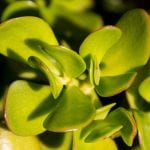
Jade
Crassula ovata, commonly known as jade plant, lucky plant, money plant or money tree, is a succulent plant with small pink or white flowers. It is native to South Africa and Mozambique, and is common as a houseplant worldwide. Probably one of my favorite houseplants. Incredibly easy to propagate. Follow the 4 Steps to Succulent Success guide above.
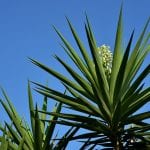
Yucca
Yucca is a genus of perennial shrubs and trees in the family Asparagaceae, subfamily Agavoideae. Its 40–50 species are notable for their rosettes of evergreen, tough, sword-shaped leaves and large terminal panicles of white or whitish flowers. They are native to the hot and dry (arid) parts of the Americas and the Caribbean. A few cultivars will live outdoors in our cold weather climate.
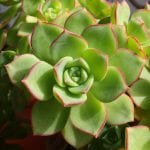
Echeveria
Plants may be evergreen or deciduous. Flowers on short stalks (cymes) arise from compact rosettes of succulent fleshy, often brightly coloured leaves. Species are polycarpic, meaning that they may flower and set seed many times over the course of their lifetimes. Often numerous offsets are produced, and are commonly known as “hen and chicks”. Many species of Echeveria serve important environmental roles, such as those of host plants for butterflies.
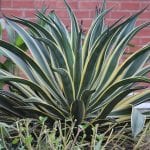
Snake Plant
Sansevieria trifasciata is a species of flowering plant in the family Asparagaceae, native to tropical West Africa from Nigeria east to the Congo. It is most commonly known as the snake plant, mother-in-law’s tongue, and viper’s bowstring hemp, among other names.
Keep on growin’
Lori York
Blue Mountain Four Season


